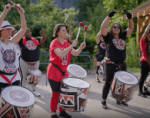
Birds of a Feather…
by Darcy Grabenstein
Across generations, in cultures around the globe, people come together as one when they break bread, make music, and move to those rhythms. Filipino culture is no exception. In Filipino culture, Patawili is traditionally a festival of farmworkers, celebrated by the Tumandok people native to the island of Panay.
Patawili 2020 is the brainchild of Annielille Gavino*, a movement artist, researcher, writer, and cultural worker. It included three virtual events in celebration of Filipino American History Month: a Kuratsa dance class, 24 hours of streamed Filipino dance films and performances, and a town hall as part of the Asian Arts Initiative’s monthly programming. I took part in the online class, taught by Los Angeles-based Paulo Alcedo and assisted by Gavino, both of whom are alumni of the Filipiniana Dance Troupe of University of the Philippines.
Kuratsa (pronounced koo-rah-cha) is a dance inspired by the Mexican La Cucaracha folk dance. The dance also features Flamenco-like movements, reflecting the fact that the Philippines were under Spanish rule from 1565 to 1868.
The dance’s Mexican and Spanish influences were a surprise to me, since the Filipino dances I encountered in my P.E. classes growing up didn’t display signs of this heritage. Gavino said these more well-known dances are Tinikling, where bamboo poles are tapped on the ground (a dance I remember from school); Pandanggo, which involves balancing lit candles; and Maglalatik, typically performed by men wearing strategically placed coconut shells that serve as percussion instruments.
Kuratsa is a dance of flirtation and courtship, designed to be danced with a partner. Its movements mimic the mating ritual of a rooster and hen. Alcedo said that different versions of the dance could be found in north and central Philippines. We learned four basic parts: walking toward each other with a waving motion of the hand; a sideways swaying motion ending with a kick; a faster, more flirtatious step-together section; and finally, the courtship phase with more hip action and shimmying.
Traditionally, men play the macho rooster and women play the flirtatious hen. But Gavino did not want to be bound by gender stereotypes and encouraged participants to choose the role that resonated the most with them. I was somewhat disappointed as I found myself gravitating toward the hen role, despite wearing pants and not a flowing skirt like Gavino.
Only a handful of people took the class, and I wish more could have experienced it. Two sets of people danced as pairs; the rest danced solo, each in our own Zoom box. With the newer Zoom features I could rearrange the boxes on my screen, so I placed Gavino to the right of Alcedo, connecting their movements in cyberspace.
I have been an avid folk dancer for decades, so my natural inclination was to compare this class with others I’ve attended. The footwork was less complicated and the pace slower, so I caught on quickly. In just a single, one-hour class, it seemed Alcedo intended for us to enjoy the music and movement, more than learn the steps with precision. Guitar and other stringed instruments, complemented by tambourines and castanets, provided a lively backdrop for the footwork (despite being at times difficult to hear over the Zoom platform).
As with my early taste of Tinikling, both Alcedo and Gavino were introduced to folk dance in their physical education classes as youths. “Folk dance helped start our love for dance arts,” Alcedo said.
Gavino explained that though folk dances such as Kuratsa have been codified for physical education classes in Filipino schools and for performances, the dances still maintain authentic, indigenous elements. She said purists consider it sacrilegious to tamper with original folk dances, adding, “Tradition is always evolving. I’m starting to see it in that lens.” Alcedo said many Filipino choreographers want to maintain tradition while contemporizing the dances, creating a “mix of worlds.”
While traditions in dance and ritual are unique to each culture, I found many connections between Filipino traditions and my own Jewish heritage. As with Patawili, our celebrations are filled with symbolic foods. Stringed instruments give Filipino music its flair; fiddles define Klezmer tunes. Filipino people dance Kuratsa; we dance the hora. In just one hour, I learned more than a simple dance sequence. By gaining insight into Filipino culture, I am able to celebrate both our differences and similarities.
*Annielille Gavino is a writer for thINKingDANCE
Patawili 2020, Annielille Gavino, online, October 25-26.
By Darcy Grabenstein
October 29, 2020









